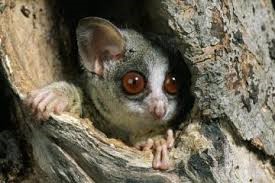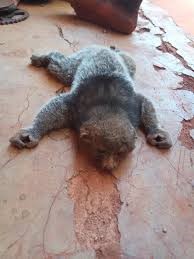Growing up in Nigeria, tales of bush babies and their eerie spiritual connotations have always been a part of our folklore. Picture yourself walking through a dense forest at night. Suddenly, the silence is broken by the unsettling sound of a baby crying. Intrigued and a bit unnerved, you wander further, trying to locate the source of the cry. As you scan your surroundings, you catch a glimpse of something darting through the trees, quick as a flash. When you finally manage to focus, you see a pair of large, round eyes staring back at you. You’ve just encountered a bush baby!
Many African tribes hold superstitious beliefs about this diminutive primate. The bush baby’s laughing and chattering sounds are often attributed to a mythical giant snake with a feathered head, adorned in rainbow colors. According to folklore, this snake kills evil intruders by pecking a neat hole in their heads.
Bush babies, also known as galagos, are small primates with large, saucer-like eyes that predominantly inhabit trees. There are at least 20 known species of galagos, though some experts believe many more are yet to be discovered. In Afrikaans, they are called nagapies, meaning “night monkeys,” a nod to their nocturnal nature.
These nocturnal creatures are perfectly adapted for life in the dark. Their big eyes help them see in low light, and their large, collapsible ears rotate independently like radar dishes to precisely locate prey in the dark. Bush babies are also exceptional jumpers, using their powerful legs and long tails to leap great distances. This agility allows them to swiftly navigate the forest canopy or snatch flying insects out of the air.

Before 1980, only six species of bush babies were recognized. However, subsequent studies, particularly focusing on their vocalizations, have led to the identification of perhaps as many as 20 species.
These small, nocturnal primates exhibit omnivorous feeding habits. They consume a varied diet, including fruit, insects, and the sap that seeps from specific tree species. Some of the larger galago species are known to hunt small animals, such as frogs and birds, adding a carnivorous aspect to their diet.
Due to their similar physical appearances, it can be challenging to distinguish between different galago species by sight alone. Instead, researchers often rely on the unique vocalizations of these animals—calls that resemble the cries of a human infant, which is likely how they earned their common name—to identify and differentiate between closely related species.
Galagos have diverse nesting preferences. Some species favor nesting in tree hollows, while others choose to hide in the crooks of trees or dense vegetation during the day. The Senegal bush baby, for instance, is known to repurpose old birds’ nests or abandoned beehives as shelters.
Typically, bush babies live in family groups of two to seven individuals. These groups spend the daylight hours huddled together in their nests but disperse at night to forage for food independently.
Bush babies face a variety of predators, including mongooses, genets, jackals, domestic dogs and cats, owls, and snakes. They are also preyed upon by several other primate species, such as grey-cheeked mangabeys and blue monkeys. Remarkably, there is evidence that chimpanzees craft spears to hunt and extract bush babies from their hiding places.

Reproduction is a crucial aspect of an organism’s life, essential for the continuation of the species. Here are some details about the reproduction of bush babies. The Senegal bush baby (Galago senegalensis) follows a gametic life cycle, remaining a multicellular diploid organism for most of its life, similar to many other mammals such as giant pandas, giraffes, hippopotamuses, and cows.
During reproduction, male and female bush babies engage in sexual intercourse, which typically lasts about nine minutes. The male’s sperm fertilizes the female’s egg, resulting in a diploid zygote. This zygote then grows through mitosis into a multicellular diploid adult. Bush babies are polygynous breeders, meaning males compete for the attention of multiple females and access to their territories. This competition is closely linked to the size of the males, with larger males often having a better chance of success.
Bush babies reproduce twice a year: once at the beginning of the rainy season in November and once at the end of the rainy season in February. During and just before the breeding seasons, male bush babies gain weight, and their testes increase in size. Several factors influence the mating and reproduction patterns of bush babies, both internal and external. These include photoperiods, the availability of mature individuals, hormones, and weather conditions.
Female bush babies typically reach sexual maturity at around 240 days old, while males mature slightly later, at about 300 days. The timing of their reproductive cycles ensures that the young are born during periods when environmental conditions are favorable for their survival. The changes in the physical condition of males, such as increased weight and testes size, are adaptations that maximize their reproductive success during these critical periods.
The synchronization of breeding with the rainy season likely provides several advantages. The abundance of food resources during and after the rains supports the nutritional needs of the pregnant females and their offspring. Additionally, the availability of water and the overall increase in biodiversity during the rainy season may enhance the survival rates of the young.
Understanding these reproductive patterns and their underlying factors is essential for the conservation and study of bush babies. By aligning their reproductive cycles with environmental cues, bush babies maximize their chances of successful reproduction and the continuation of their species.
Overall, bush babies are a remarkable example of how biological traits, environmental factors, and human culture can intersect, creating a captivating subject for both scientific inquiry and cultural storytelling. Their resilience and adaptability ensure that they remain an integral part of Africa’s diverse and vibrant wildlife.
Sources
- https://www.nationalgeographic.com/animals/mammals/facts/bushbabies#:~:text=Bush%20babies%2C%20also%20called%20galagos,all%20galagos%20are%20considered%20nocturnal
- https://www.britannica.com/animal/lemur-primate-suborder
- https://www.nationalgeographic.com/animals/mammals/facts/bushbabies
- http://bioweb.uwlax.edu/BIO203/f2013/degner_kell/reproduction.htm#:~:text=The%20sperm%20from%20the%20male,access%20to%20multiple%20female%20territories.




